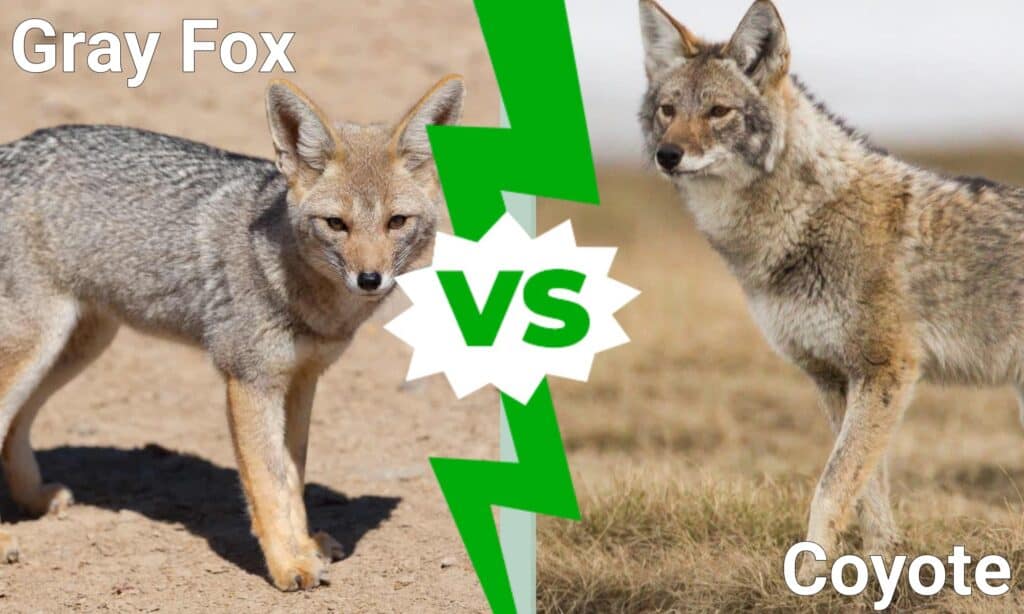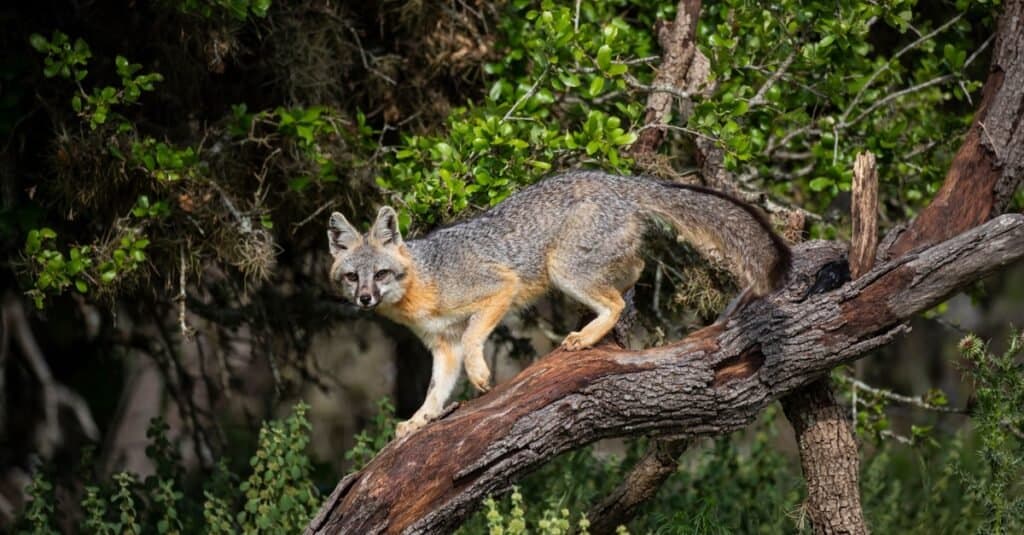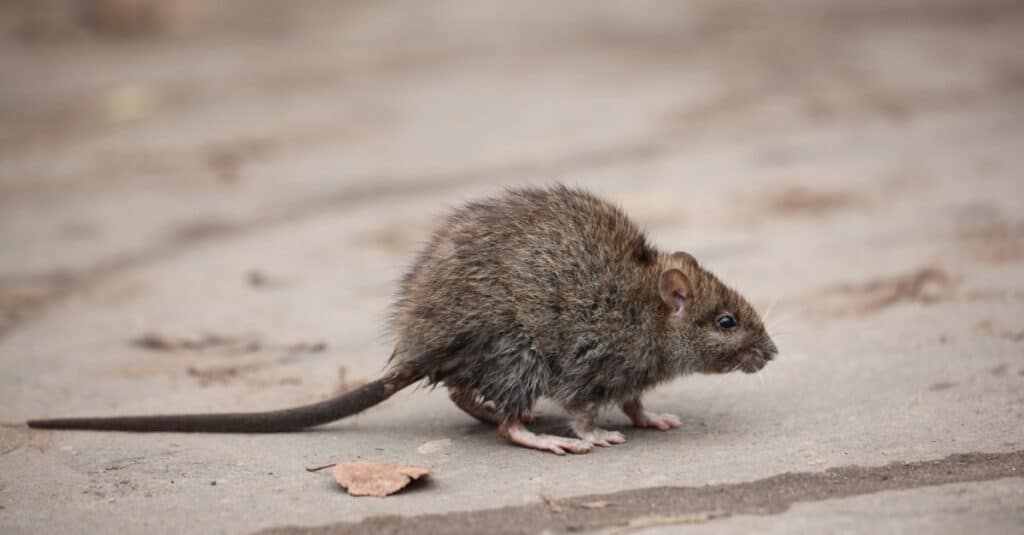The gray fox and the coyote are both members of the dog family and both are wild animals. But while the gray fox and the coyote may share some similarities, they are very different from each other. We compare these two animals in terms of their sizes, diets, and more. Explore the gray fox vs. coyote comparison table below:

| Gray Fox | Coyote | |
|---|---|---|
| Scientific Name | Urocyon cinereoargenteus | Canis latrans |
| Height | 12 – 16 inches | 21 – 24 inches |
| Weight | 7.9 – 15.4 pounds | 15 – 44 pounds |
| Habitat | Rocky wooded areas, Southern Canada to Northern part of South America | Plentiful throughout North America |
| Diet | Omnivorous hunter | Carnivorous |
| Behavior | Nocturnal, solitary animals | Pack animals |
| Conservation Status | Least concern | Least concern |
Gray Fox vs Coyote Size and Appearance
The gray fox is a medium-sized canid, measuring between 12 and 16 inches tall. In terms of weight, this animal usually reaches between 7.9 and 15.4 pounds. They grow to 39.9 and 44.3 inches, and their bushy tails can be as long as 17.4 inches of their total length. Not surprisingly, female gray foxes are only slightly smaller than males.
Gray foxes are easily distinguishable from other canids. They have a silvery upper body with a vivid black stripe down the center of their back and tail. The head of a gray fox has u-shaped temporal ridges, and the muzzle and ears are pointed and angular. The paws of the gray fox are oval, with four triangular-shaped toes, with each nail longer and more curved than the coyote, enabling them to climb trees.
The coyote is much bigger than the gray fox, with males ranging from 21 to 24 inches tall and weighing between 18 and 44 pounds. Female coyotes tend to be smaller and typically weigh between 15 and 40 pounds.

Coyotes are much larger than gray foxes and hunt in pairs or groups, whereas gray foxes are solitary, nocturnal animals.
©GatorDawg/Shutterstock.com
Coyotes differ in size and color, depending on their location. For example, desert coyotes are mostly whitish gray, while those that live in mountain areas have more black and gray shading. Coyotes in other regions are predominantly red and light gray, with some having brown and black spots.
Coyotes have longer ears and bigger heads than gray foxes. They are thin-framed animals with long legs, faces, and muzzles. Coyote feet are less rounded and more elongated than those of the more delicate gray fox.
Gray Fox vs. Coyote: Habitat

The gray fox is common in North and Central America.
©Danita Delimont/Shutterstock.com
The gray fox is common throughout North and Central America. This animal was also common throughout the eastern U.S. at one time. However, deforestation and human advancement have led to a decline in numbers. The gray fox prefers wooded areas but is adaptable. This adaptability has made it possible for it to live in suburban environments like southern Florida. Additionally, the gray fox is still abundant in the Great Lakes and the Pacific States.
Coyotes are plentiful throughout North America. They are highly adjustable and are familiar sights in some urban areas. Moreover, these animals live in various places, including mountains and deserts.
Diet
The gray fox is a solitary hunter. It is also omnivorous and an opportunistic feeder. In the eastern U.S., the gray fox mostly hunts voles, mice, birds, and rabbits. But besides being omnivorous, the gray fox is primarily herbivorous and insectivorous in some parts of the western U.S. In these areas, the gray fox will eat many fruits and invertebrates. For example, in California, they consume a lot of rabbits and other rodents.

The gray fox is an opportunistic feeder and can be omnivorous, herbivorous, or insectivorous, eating rats, voles, rabbits, fruits, nuts, and seeds. The gray fox can also climb trees.
©iStock.com/Kichigin
Another interesting fact about this animal is that it can also climb trees to raid bird nests. Consequently, they will store fruits, nuts, and seeds during seasonal changes from winter to spring. Moreover, gray foxes serve as an important regulator of rodent populations.
Coyotes often hunt in pairs or small groups. They are carnivorous and voracious hunters and despite hunting in groups, will also catch small prey on their own. Their prey ranges from mice and ground squirrels to larger deer and farm animals.
A breeding pair will usually hunt large animals together, leaving younger, more inexperienced pack members out of the hunt. Coyotes may even form partnerships with American badgers. Additionally, coyotes are opportunistic feeders and will eat scraps of food found in human trash.

Coyotes are carnivores and may form partnerships with American badgers to hunt prey that includes the gray fox, ground squirrels, deer, and farm animals.
©Steve Boice/Shutterstock.com
Coyote vs Gray Fox: Behavior
Coyotes tend to have large territorial ranges and will only defend dens and territory during their mating season. Additionally, coyote dens are found in a wide variety of places.
Coyotes are known to walk three to ten miles daily looking for meals. Their initial home environment was mainly in grasslands, but their range has increased because of dwindling wolf populations.
The gray fox is a solitary animal, living in dens, usually in hollowed-out trees or stumps. And because the gray fox is nocturnal, it sleeps during the day. Bobcats and coyotes are well-known predators of gray foxes. Besides, gray foxes will climb trees to avoid dogs or other predators. Since coyotes have invaded most of their territory, gray foxes increasingly live in suburban areas.
Reproduction
Gray foxes form monogamous pairs, and breeding occurs from February to March. Females will birth as many as seven pups, although the average is four. Female gray foxes are sexually mature around ten months, with males becoming mature earlier and staying fertile longer. Parents will teach their fox kits to hunt at three months. They do this with family groups splitting up in the fall and the young males moving further away than young females. Gray foxes usually live between six to ten years.
Coyotes live in familial packs containing one reproductive female. Females enter estrus during midwinter and will mate with one male. The average litter of coyote pups is six. Male coyotes will hunt on their own and bring back food for their pregnant mate. Both the male and female coyotes will build a den or clear out abandoned burrows. Coyote pups are born deaf and blind and entirely dependent on their parents. Both male and female coyotes take care of their young. Young coyotes start eating solid food at 15 days. They will be fully weaned and hunting with their parents in four months.
The photo featured at the top of this post is © JayPierstorff/Shutterstock.com
Thank you for reading! Have some feedback for us? Contact the AZ Animals editorial team.






